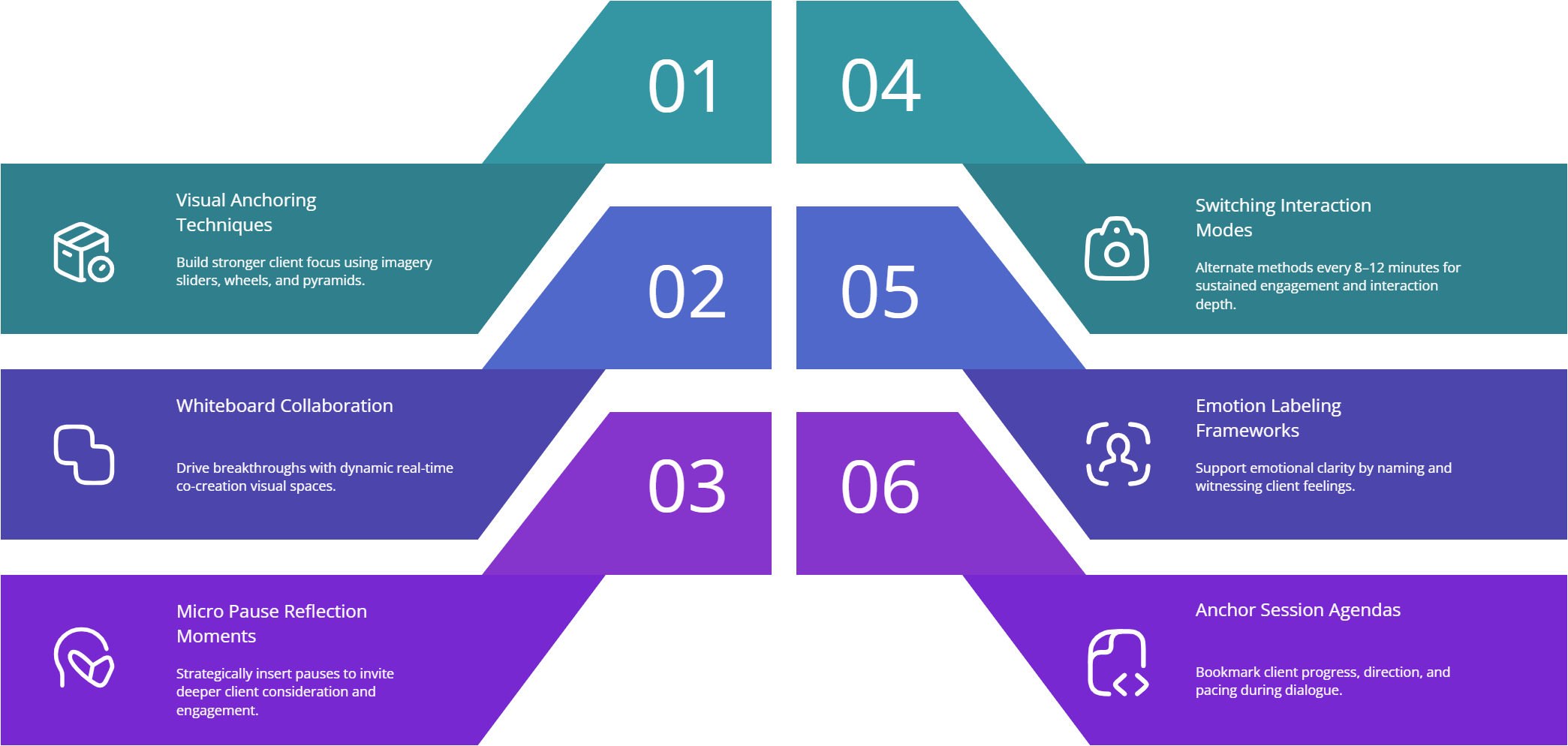Video Conferencing Hacks for Flawless Online Coaching Sessions
Online coaching has become the backbone of modern client transformation, and your video-conferencing setup plays a direct role in how clients perceive your authority, professionalism, and expertise. Every detail—camera angle, audio warmth, lighting depth, engagement rhythm, and session flow—helps determine whether clients stay fully present or mentally check out. This guide gives you elite-level, battle-tested video hacks used by top coaches who deliver premium virtual outcomes at scale. Expect zero fluff and nothing generic—only advanced, implementation-ready tactics backed by resources like the Wheel of Life Reinvented, SMART Goals 2.0, and Coaching Tools for Professionals.
1. Mastering Your Technical Foundation for Zero-Glitch Coaching Sessions
A flawless coaching experience starts with technical mastery—long before the first powerful question is asked or the first breakthrough appears. Clients subconsciously assess your professionalism the moment your camera loads. A grainy webcam, poor lighting, hollow-sounding audio, or intermittent lag instantly weakens perceived competence, even when your frameworks are world-class. This is why advanced coaches build a robust technical foundation rooted in consistency, redundancy, and professional clarity—practices reinforced inside Powerful Questioning Techniques, Executive Coaching Career Path, and Launching a Successful Health Coaching Career.
High-performance setup essentials include:
Using a dedicated microphone instead of laptop audio.
Choosing a DSLR-style webcam for clear facial detail.
Keeping your router within 8–10 feet of your coaching desk.
Running all sessions through an Ethernet connection, not WiFi.
Preparing a backup device logged in and ready to switch instantly.
Testing audio/video 5 minutes before every session—non-negotiable.
These micro-optimizations eliminate friction, reduce miscommunication, and help clients feel fully safe, present, and guided.
2. Creating a Premium Coaching Environment Through Smart Video Setup
Clients don’t judge your coaching quality first—they judge your environment. Even if your frameworks rival the best inside the Certified Life Coach Guide or Coaching Session Templates, a dim room, messy background, distorted camera angle, or inconsistent lighting breaks trust immediately.
A premium coaching environment communicates:
Focus (nothing distracts client attention)
Stability (your setup looks intentional, not improvised)
Authority (your presence projects confidence)
Professionalism (you treat coaching like a business, not a hobby)
High-ROI techniques include:
Three-point lighting for depth and emotional warmth
Cinematic background blur that emphasizes your expressions
Brand-aligned colors reinforcing your identity
A quiet, acoustically soft space to eliminate echo and noise
This environment tells clients: You’re safe here. You can open up. You’re guided by someone who takes this work seriously.
3. Coaching Presence: How to Command the Room Through the Screen
Digital presence is a skill—not an accident. Unlike in-person sessions, where energy naturally fills a room, online coaching compresses presence through a small rectangle. To counteract this, elite coaches intentionally project presence through visual, verbal, and psychological calibration—principles echoed inside the Wheel of Life Reinvented and SMART Goals 2.0.
High-impact presence techniques:
Keep eyes near the lens (client feels seen).
Use “micro-nods” during emotional disclosures.
Mirror posture slowly to build subconscious rapport.
Use silence strategically to amplify breakthroughs.
Summarize after every shift of emotion or insight.
Use naming: “Here’s what I’m noticing…”
Position hands within the frame for expressive clarity.
Presence isn’t charisma—it’s the art of consistent psychological attunement.
Poll: What Creates the Most Stress During Your Online Coaching Sessions?
4. Advanced Client Engagement Tactics for High-Impact Video Sessions
Client engagement online is fragile. Micro-distractions, subtle multitasking, shifting screen focus, and emotional distance make virtual coaching uniquely challenging. This is why you must weave in methods like visual anchoring, modality switching, and reflective mirroring—supported by frameworks inside Powerful Questioning, Top Coaching Trends 2025, and Coaching Tools Every Professional Needs.
Elite engagement techniques include:
Visual metaphors using sliders, dials, pyramids, or wheels.
Whiteboard co-creation for real-time breakthroughs.
Micro-pauses to emphasize reflection moments.
Modality switching every 8–12 minutes:
Talking → Visual → Writing → Reflection → Strategy.Emotion labeling: “It sounds like you’re feeling…”
Agenda bookmarks to maintain direction and pacing.
High-engagement sessions produce clarity, trust, and transformation.
5. Scaling Your Video Coaching: Automation, Tools & Workflow Optimization
Scaling means your system—not you—handles the logistics. Automation enhances delivery consistency while freeing 10–20 hours weekly, allowing you to grow using strategies highlighted in Outsourcing Secrets, Hidden Revenue Streams, and Strategic Expansion Guide.
High-scale tactics:
Use Zoom AI for automatic summaries and timestamps.
Use automated emails for client onboarding, reminders, and prep instructions.
Create session templates to cut planning time by 60–70%.
Build resource libraries for each transformation phase.
Use tag-based CRMs to track client emotional states, progress, and patterns.
Group-record frameworks and integrate them into self-paced programs for hybrid coaching.
Your coaching business becomes scalable when it runs on systems, not on your bandwidth.
6. FAQs — Real-World Solutions for Video Coaching Problems
-
Integrate micro-engagements: ask them to summarize insights, annotate shared screens, or co-build frameworks. Switch modalities frequently.
-
Use Speaker View with a slightly zoomed-in frame to capture subtle expressions and maintain relational depth.
-
Send a pre-session tech guide + a checklist. Offer a “low-tech mode”: audio-only with shared notes.
-
Yes, if clients consent. Recordings reinforce accountability and deepen reflection between sessions.
-
Pre-frame silence as a tool: “I pause to help you process your insights.” This turns silence into psychological safety.
-
Use a dynamic mic, close-mic your delivery, eliminate background noise, and treat echo with soft furnishings.
-
Use a micro-script: “Give me 20 seconds while I refresh.” Calm tone + quick recovery = retained authority.


